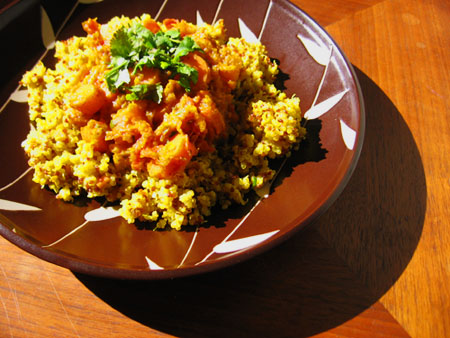I’m totally enjoying the feature on wordpress that lets me see what google search phrases have led people here, to my box. I get a lot of visitors on “aphid” related searches, and surprisingly few on “community supported agriculture” related ones. (Although I get a lot of CSA-specific visitors clicking over from the Eatwell list of member blogs and from the post on Chowhound about choosing a CSA.)

Super Easy Pan-Cooked Spinach Fritatta with Humboldt Fog cheese, green garlic, spring onion, and thyme (medium-pan sized, cut in half) with a salad of lettuce, red cabbage, cauliflower, carrot, and sugar snap peas
One surprising search phrase that shows up almost every day, sometimes in multiple versions, is some variation of “spinach for breakfast.” Which is, of course, the title of a post I made back in February extolling the pleasures of spinach as a breakfast food. My first thought of course is, “Wow, there sure are a lot of people who want to know about eating spinach for breakfast. Huh.” My next thought every time I see that someone’s search for breakfast-spinach information led them here is a bit of guilt. Because my first Spinach for Breakfast post is more about my personal, heartwarming journey to spinach acceptance than it is a helpful guide on how to use spinach in one’s morning meal. Which I assume is what all these googlers are googling for.
So I decided to revisit the topic of spinach for breakfast. It gives me an excuse to share a recipe I’ve been wanting to share. The other morning I was cooking breakfast (it involved spinach, of course) and thinking about how much this one recipe, which isn’t even a recipe but more of a technique, completely changed my breakfast life. I used to think I was “not a breakfast person” and “not an egg cooker” because fried eggs bored me, scrambled eggs eluded me, and frittatas were special occasion food involving all kinds of fancy cooking and flipping using plates or pans with heat-proof handles so you could finish them in the oven.

Super Easy Pan-Cooked Frittata with Carmody cheese and thyme (small-pan sized, whole), tempeh bacon, and fruit salad with pomelo, kiwi, apple, and mint
This technique is usually how spinach ends up in my breakfast, but it’s also a great, simple way to incorporate most any kind of leftover into a hot, pleasing morning meal. It’s so obvious that I feel a little silly even writing it down, but I so distinctly remember the change in breakfast, from before I practiced this to after, that it seems worth taking the time to share it.
Recipe below… Continue reading →










